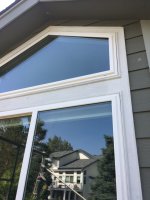Mike Goetzke
Member
- Joined
- Jul 12, 2008
- Messages
- 1,161
I'm in the Chicago area and my house is 40 years old. I have a tri-level brick house with the upper level sided with douglas fir RBB (think that's what it's called). Last fall I replaced most of the fascia and just received three replacement windows for upstairs - getting ready to paint this year. Then my wife tells me I should replace the siding with something more maintenance free.
I don't like vinyl because of the expansion/contraction and noise associated with it so I see the hardie and LP being used a lot. When I investigate the two there seems to never be an unbiased review.
Would appreciate feedback on experience with the new siding materials. Ha - as well as just re-painting (this is what I want to do to save $$$).
Thanks Mike
I don't like vinyl because of the expansion/contraction and noise associated with it so I see the hardie and LP being used a lot. When I investigate the two there seems to never be an unbiased review.
Would appreciate feedback on experience with the new siding materials. Ha - as well as just re-painting (this is what I want to do to save $$$).
Thanks Mike



